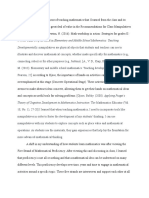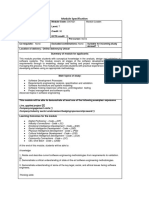0 ratings0% found this document useful (0 votes)
39 viewsTittle: Gesturing Gives Children New Ideas About Math
This study examined how gestures affect children's learning of math concepts like addition. The experiment tested three conditions: gestures, no gestures, and partial gestures. Children who learned with gestures scored higher on post-tests than those in other conditions, showing that gestures can enhance math learning by engaging the body. However, the study did not include speech, so the impact of combining gestures and words requires further investigation.
Uploaded by
aslam janCopyright
© © All Rights Reserved
Available Formats
Download as DOCX, PDF, TXT or read online on Scribd
0 ratings0% found this document useful (0 votes)
39 viewsTittle: Gesturing Gives Children New Ideas About Math
This study examined how gestures affect children's learning of math concepts like addition. The experiment tested three conditions: gestures, no gestures, and partial gestures. Children who learned with gestures scored higher on post-tests than those in other conditions, showing that gestures can enhance math learning by engaging the body. However, the study did not include speech, so the impact of combining gestures and words requires further investigation.
Uploaded by
aslam janCopyright
© © All Rights Reserved
Available Formats
Download as DOCX, PDF, TXT or read online on Scribd
You are on page 1/ 3
Tittle
Gesturing Gives Children New Ideas About
Math
The purpose of this study was to show how
gesture can enhance math performance. It
was an experimental research study that
looked at how gesture effects children’s
learning of math, particularly addition. The
independent variable was gesture with three
different conditions; gesture, no gesture, and
partial gesture. The dependent variable of the
study was the difference between pre- and
post- test scores on a math task.
The lesson was where the independent
variable change.Once the pre-test was graded,
a lesson was given either with gesture that
was grouping through two fingers, no gesture
or a partial gesture which was just pointing.
Once the lesson on the math was given, the
post-test was given. The experimenters then
determined a difference from pre- to post-
tests scores.
The major conclusion to this study was that
the gesturing condition showed higher math
scores than the partially correct which was
higher than the no gesture condition, showing
that the gesturing actually aided in the child
remembering the math task by using their
body to perform it.
However in this study there was no speech
within the lesson.Since this was the only
speech, the lesson was highly dependent on
the use of the gestures, which in my opinion
could be questionable. The questions arise,
should gesture be tested with more verbal
instruction. Does the gesture give the same
effect? One may also ask, does this relate to
older or younger kids who are learning a
different type of math?
Summary
Gesturing gives children new ideas about
math. The purpose of this study was to show
how gesture can help us improve math
performance.
The one of the major conclusion to this study
was that the children with gesturing condition
showed higher math scores than the partially
correct which was higher than the no gesture
condition, thus showing us that the gesturing
actually aided in the child and remembering
the math task by using their body to perform
it.
You might also like
- Presentation SG9a - Developing Thinking Skills - How Children Learn Math100% (2)Presentation SG9a - Developing Thinking Skills - How Children Learn Math25 pages
- Gesturing Gives Children New Ideas About Math: Research ReportNo ratings yetGesturing Gives Children New Ideas About Math: Research Report6 pages
- Teachersõ Gestures Facilitate Studentsõ Learning: A Lesson in SymmetryNo ratings yetTeachersõ Gestures Facilitate Studentsõ Learning: A Lesson in Symmetry18 pages
- The Effect of Gestured Instruction On The Learning of Physical Causality ProblemsNo ratings yetThe Effect of Gestured Instruction On The Learning of Physical Causality Problems20 pages
- Goldin-Meadow (2001) Explaining Math. Gesturing Lightens The LoadNo ratings yetGoldin-Meadow (2001) Explaining Math. Gesturing Lightens The Load7 pages
- How Our Hands Help Us Learn: Susan Goldin-Meadow and Susan M. WagnerNo ratings yetHow Our Hands Help Us Learn: Susan Goldin-Meadow and Susan M. Wagner8 pages
- Annotated Bibliography: Making Math Fun and EngagingNo ratings yetAnnotated Bibliography: Making Math Fun and Engaging4 pages
- Improving Multiplication and Division Automaticity Using SplashlearnNo ratings yetImproving Multiplication and Division Automaticity Using Splashlearn17 pages
- Enhancing the Numeracy Skills of Grade One Pupils at Talisay Elementary School_2No ratings yetEnhancing the Numeracy Skills of Grade One Pupils at Talisay Elementary School_225 pages
- Unit 3: Cycle-Task - Task 3: December 2018No ratings yetUnit 3: Cycle-Task - Task 3: December 20188 pages
- Sample Pages: Approaches To Mathematics Teaching and LearningNo ratings yetSample Pages: Approaches To Mathematics Teaching and Learning20 pages
- Benefits of Early Numeracy at Home Math EssayNo ratings yetBenefits of Early Numeracy at Home Math Essay16 pages
- From Everyday To Scientific (Mathematical) Concepts: A Vygotskian Interpretation of A Young Child's SpeechNo ratings yetFrom Everyday To Scientific (Mathematical) Concepts: A Vygotskian Interpretation of A Young Child's Speech14 pages
- EM2_How to Help Students Build Deep Understanding of Math Concepts_Final Web_3.28.22No ratings yetEM2_How to Help Students Build Deep Understanding of Math Concepts_Final Web_3.28.227 pages
- Boosting Mathematics Achievement With Game-Based LearningNo ratings yetBoosting Mathematics Achievement With Game-Based Learning1 page
- 2 PROO A Meta Analysis of The Effects of Instructional Interventions On Students Mathematics Achievement Egbert Harskamp EaNo ratings yet2 PROO A Meta Analysis of The Effects of Instructional Interventions On Students Mathematics Achievement Egbert Harskamp Ea37 pages
- Kate Bowski: Common Core Edition Whole Brain Teaching67% (3)Kate Bowski: Common Core Edition Whole Brain Teaching37 pages
- Integration of Puzzle S - Oreza B. TinoNo ratings yetIntegration of Puzzle S - Oreza B. Tino21 pages
- 2022 Breive Abstraction and Embodiment Exploring The Process oNo ratings yet2022 Breive Abstraction and Embodiment Exploring The Process o18 pages
- Improving Multiplication and Division Automaticity in Elementary EducationNo ratings yetImproving Multiplication and Division Automaticity in Elementary Education29 pages
- Immediate download Teach Your Kids Math Column Addition 1st Edition Sunil Tanna ebooks 2024100% (2)Immediate download Teach Your Kids Math Column Addition 1st Edition Sunil Tanna ebooks 202437 pages
- The Effect of Manipulatives on the Performance of Mathematical Problems in Elementary School ChildrenFrom EverandThe Effect of Manipulatives on the Performance of Mathematical Problems in Elementary School ChildrenNo ratings yet
- Lab VII (Misc. Advanced Expt.) : Name M.Qasim Reg No. L1F16BSPH7007No ratings yetLab VII (Misc. Advanced Expt.) : Name M.Qasim Reg No. L1F16BSPH70077 pages
- Training Programmes of The MIE: Secondary SectorNo ratings yetTraining Programmes of The MIE: Secondary Sector6 pages
- Quiz 2 - Dimensionality reduction_ Machine Learning 3 - RaviNo ratings yetQuiz 2 - Dimensionality reduction_ Machine Learning 3 - Ravi5 pages
- Good DESIGN THINKING Book by Dharam MentorNo ratings yetGood DESIGN THINKING Book by Dharam Mentor78 pages
- SDLP 03 - Organization Theories and Applications100% (1)SDLP 03 - Organization Theories and Applications4 pages
- Military Learning and Competing Theories of ChangeNo ratings yetMilitary Learning and Competing Theories of Change18 pages
- Ninth Grade Art of Persuasion Unit PlanNo ratings yetNinth Grade Art of Persuasion Unit Plan38 pages
- The Certainty Paradox of Student History Teachers - Balancing Between Historical Facts and Interpretation-MainNo ratings yetThe Certainty Paradox of Student History Teachers - Balancing Between Historical Facts and Interpretation-Main12 pages
- Complete Psychology in Your Life Third Edition Grison PDF For All Chapters100% (1)Complete Psychology in Your Life Third Edition Grison PDF For All Chapters79 pages
- EDUC 110 Building and Enhancing New Literacies Across The CurriculumNo ratings yetEDUC 110 Building and Enhancing New Literacies Across The Curriculum8 pages
- Rockwoods International School, Udaipur: Session - 2022-23No ratings yetRockwoods International School, Udaipur: Session - 2022-232 pages
- Mini Research and Project Productive Written Language SkillsNo ratings yetMini Research and Project Productive Written Language Skills10 pages





























































































